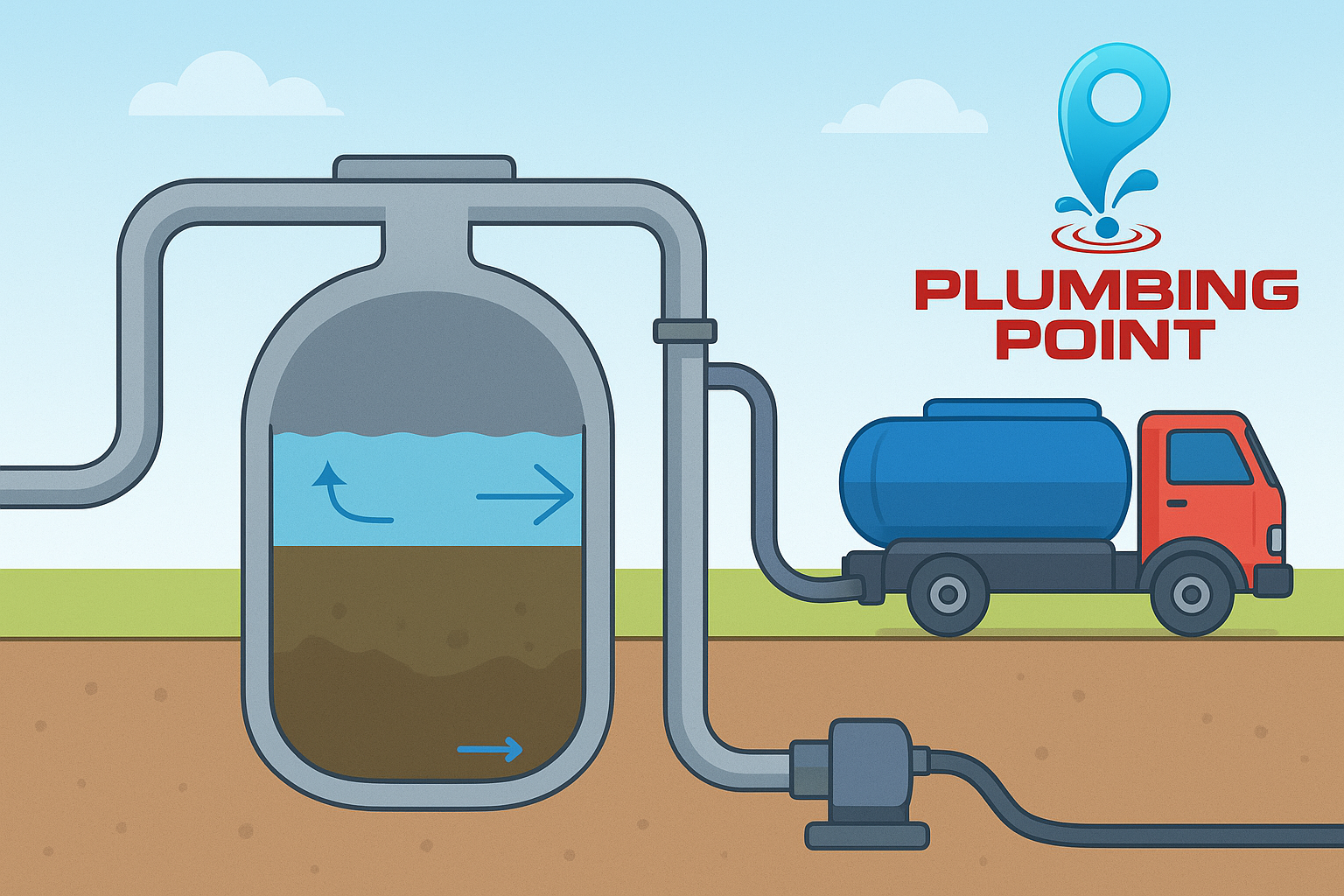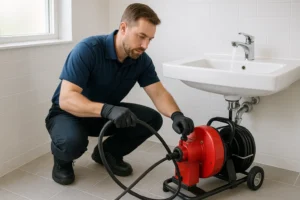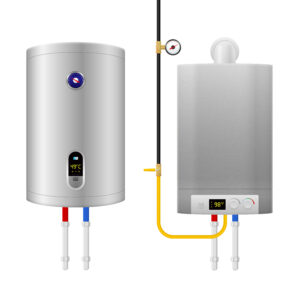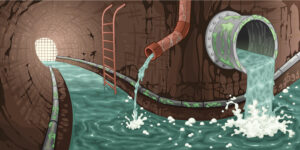|
Getting your Trinity Audio player ready...
|
Flushing the toilet and watching everything vanish feels simple. But if your home uses a septic tank system, that flush triggers a fascinating process hidden underground. Millions of U.S. homes rely on septic tanks, yet most homeowners don’t fully understand how they work — or how costly repairs can become when they’re neglected.
At Plumbing Point Inc., we’ve seen it all — from clogged tanks to cracked drain fields. Homeowners who understand how a septic system functions make smarter choices, prevent breakdowns, and save thousands of dollars. This guide explains how does a septic tank work, step by step, plus maintenance tips, warning signs, and professional insights to keep your system healthy for decades.
What is a Septic Tank?
A septic tank is an underground chamber made from durable materials such as concrete, fiberglass, or heavy-duty plastic. Its main purpose is to separate solid waste from liquid waste and begin the natural breakdown of organic matter. When wastewater from toilets, showers, and sinks enters the tank, heavier solids sink to the bottom to form sludge, lighter materials like oils and grease rise to the top to form a scum layer, and the middle layer of liquid, known as effluent, eventually moves out into the drain field for further filtration.
How Does a Septic Tank Work? Step by Step
The process starts the moment wastewater leaves your home. Everything travels through a main sewer pipe into the septic tank. Inside, gravity takes over as solids settle and fats float, leaving liquid in between. Naturally occurring bacteria immediately begin digesting the organic solids, reducing their volume and converting them into sludge at the bottom.
Over time, as new wastewater enters, older effluent flows out through an outlet pipe into the drain field. Once in the soil, water passes through layers of gravel and earth that naturally remove harmful bacteria and pathogens before eventually returning to the groundwater supply. This cycle, repeated daily, ensures safe and environmentally friendly waste management for homes that are not connected to public sewers.
Step 1: Wastewater enters the septic tank
Everyday activities like flushing toilets, taking showers, doing laundry, and washing dishes generate wastewater in your home. This wastewater flows through your plumbing system and into the septic tank via the main drainage pipe.
Step 2: Solids separate from the wastewater
Inside the tank, heavier solids sink to the bottom, forming sludge, while lighter substances like oils and grease float to the surface, creating a scum layer. Between these two layers, liquid wastewater remains. Naturally occurring bacteria begin breaking down the solid waste, reducing it into sludge.
Step 3: Initial treatment inside the tank
As bacteria continue their work, the middle layer of liquid undergoes partial treatment. While not fully purified, this effluent is less contaminated than raw sewage.
Step 4: Effluent flows out of the tank
The partially treated effluent then exits the tank through an outlet pipe and travels into the drain field for further natural treatment.
Step 5: Final filtration in the drain field
In the drain field, the effluent is distributed through perforated pipes into surrounding gravel and soil. As it seeps downward, the soil acts as a natural filter, removing harmful bacteria, viruses, and impurities. Eventually, this cleaned water percolates into the groundwater system, safely rejoining the water cycle.
The importance of the drain field
The drain field plays a vital role in keeping the environment and public health safe. It captures and neutralizes harmful microorganisms in the effluent before they can reach groundwater sources. Without this natural filtering system, untreated wastewater could pose serious risks to both people and animals.
Components of a Septic System
A working septic system is made up of four essential parts. The first is the sewer line that carries waste from the home. The second is the septic tank itself, which receives and processes the waste. The third is the outlet pipe, which moves effluent into the drain field. Finally, the drain field and surrounding soil act as a natural filtration system. When all of these components work in harmony, your household wastewater is treated effectively without endangering your property or the environment.
How Deep Are Septic Tanks Buried?
The depth of a septic tank varies based on soil conditions, water table levels, and local building codes. In most cases, they are buried anywhere from a few inches below the surface to several feet underground. Shallow tanks are easier to access but can be more vulnerable to freezing during harsh winters, while deeper tanks require specialized pumping equipment but benefit from better insulation.
The Science Behind Waste Breakdown
The real magic inside a septic tank is performed by bacteria. These microscopic workers thrive in the oxygen-free environment of the tank, digesting organic solids and breaking them down into sludge. Oils and grease that float on top remain relatively unchanged, forming a scum layer. When the bacterial balance is disrupted by household chemicals, antibacterial cleaners, or improper waste disposal, solids accumulate faster than the system can handle. This leads to backups, blockages, and the potential for costly drain field failure.
The Role of the Drain Field
After effluent leaves the tank, it enters the drain field where perforated pipes distribute it evenly across gravel beds. From there, the surrounding soil filters out harmful organisms and excess nutrients. If the drain field becomes saturated with too much water, untreated wastewater can rise to the surface, creating wet patches in your yard and releasing unpleasant odors. This not only damages your property but also presents a serious health hazard.
Signs of Septic System Problems
There are several warning signs that a septic system is struggling. Slow-draining sinks, tubs, or toilets are usually the first red flag. Unusual gurgling sounds from your plumbing can also signal trouble. Outdoors, standing water or spongy patches in your lawn may indicate an overfilled drain field. Strong odors near the tank or field are another clear indicator that something is wrong. In some cases, unusually green and lush grass over the system is a symptom of leaks enriching the soil with excess nutrients.
Septic Tank Pumping Explained
Over time, sludge and scum accumulate in the tank. Pumping is the process of removing these materials to restore balance and keep the system functioning correctly. Without pumping, solids can block the outlet pipe and flow into the drain field, causing irreversible damage that often requires complete system replacement. Pumping is therefore one of the most essential maintenance tasks for any septic system owner.
How Often Should a Septic Tank Be Pumped?
The frequency of pumping depends on household size, water usage, and tank capacity. For a family of four, pumping every two to three years is recommended. Smaller households may be able to wait three or five years, while larger families or homes with heavy water use may need annual service. The presence of garbage disposals, frequent laundry, and excessive grease disposal can all shorten the pumping interval.
DIY vs Professional Septic Service
Attempting to pump or repair a septic system without professional help is dangerous and often more expensive in the long run. Septic tanks contain toxic gases that can be fatal in confined spaces. Licensed professionals, plumbers on the other hand, use specialized vacuum trucks, inspection cameras, and safety equipment. They also have the expertise to spot early warning signs of leaks, cracks, or failing drain fields.
Septic Tank Maintenance Tips
Septic systems can last decades if treated properly. Regular inspections and pumping are the foundation of good maintenance. Avoid flushing non-biodegradable items, grease, or chemicals that disrupt bacterial activity. Conserve water whenever possible to reduce strain on the system, and spread out high-usage tasks like laundry to prevent overloading the tank. Protect your drain field by never parking vehicles or placing heavy structures on top of it.
What Not to Flush Into a Septic Tank
Everyday household items are often mistakenly flushed, but they can cause major problems. Grease and oil congeal inside pipes, creating blockages. Wipes, paper towels, and feminine hygiene products do not break down and can clog the system. Harsh cleaners and bleach kill the bacteria your tank depends on, leading to faster sludge buildup. Even cat litter, though natural, is too dense for septic systems to handle.
Seasonal Care for Septic Systems
Septic tanks need care throughout the year. In winter, keeping snow cover or mulch over the system helps prevent freezing. In spring, heavy rains can oversaturate the drain field, making inspections vital. Summer is often the season of highest water use, so water conservation is especially important. Fall is the best time to schedule pumping before the ground freezes and access becomes difficult.
Cost of Septic Tank Services
Routine septic tank pumping typically costs between two hundred fifty and six hundred dollars, depending on tank size and accessibility. Inspections may range from one hundred fifty to three hundred dollars. Minor repairs can cost a few hundred, but major drain field replacement can climb into the tens of thousands. These numbers highlight why preventative care is always the smarter investment.
How Long Do Septic Tanks Last?
Most septic tanks last twenty to forty years when properly maintained. The drain field usually needs replacement after twenty to thirty years, depending on soil conditions and water usage. Neglected systems, however, may fail in less than a decade.
Environmental Benefits of Septic Systems
When maintained correctly, septic systems are environmentally friendly. They naturally recycle water back into the groundwater supply and filter out harmful bacteria before it can spread. Properly functioning septic systems reduce pollution in lakes, rivers, and streams and contribute to sustainable water management in rural and suburban communities.
Septic Tank Safety Concerns
Septic systems are not just mechanical; they are biological ecosystems that must be treated with caution. Tanks contain harmful gases such as methane and hydrogen sulfide, which can be fatal even with brief exposure. For this reason, homeowners should never attempt to enter a tank themselves. All maintenance and pumping should be left to trained professionals.
Why Professional Septic Inspections Matter
Regular inspections are the most effective way to avoid septic emergencies. A professional can identify leaks, cracks, and early drain field stress long before they turn into expensive problems. Annual or biannual inspections provide peace of mind and protect both your home and your health.
Plumbing Point Inc. Septic Services
Plumbing Point Inc. is dedicated to helping homeowners protect their investment with reliable septic services. From routine pumping and inspections to emergency backups and drain field repair, our team combines advanced equipment with years of expertise. We take pride in delivering fast, professional service that keeps your septic system safe, efficient, and worry-free.
Conclusion
Understanding how does a septic tank work is essential for every homeowner who relies on one. With the right care, a septic system can last decades, protect your home, and safeguard the environment. But neglecting it leads to expensive repairs, health risks, and property damage. Plumbing Point Inc. provides professional pumping, inspection, and repair services designed to keep your system running smoothly year after year. By trusting experienced professionals, you can avoid emergencies and enjoy the peace of mind that comes with a healthy, functioning septic system.
People Also Asked Questions (FAQs)
How does a septic tank work?
A septic tank separates solids from wastewater, digests organic matter with bacteria, and releases treated effluent into the soil for filtration.
How often should a septic tank be pumped?
Most households should schedule pumping every two to three years, though larger families may need more frequent service.
What are the signs of a failing septic system?
Slow drains, unpleasant odors, sewage backups, and standing water in your yard are common indicators.
Can additives help my septic system?
Most store-bought additives are unnecessary and may even damage the natural bacteria inside your tank.
How long will a septic tank last?
With proper maintenance, a septic tank can last between twenty and forty years.
What items should never enter a septic system?
Grease, wipes, paper towels, harsh chemicals, and feminine hygiene products should always be kept out.




